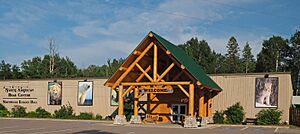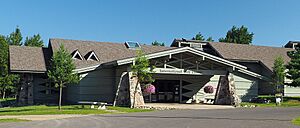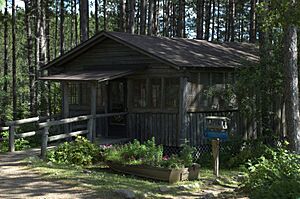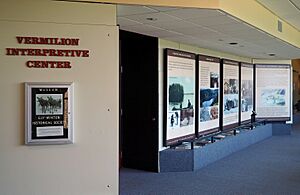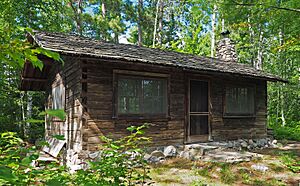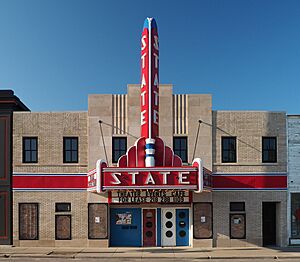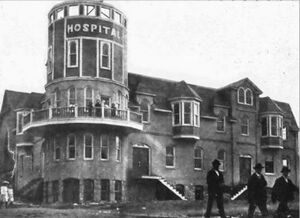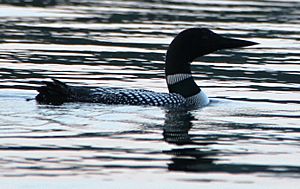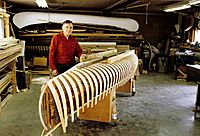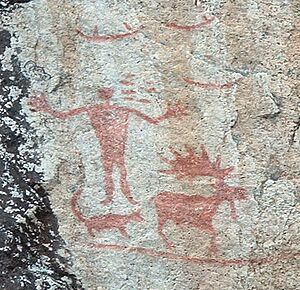Ely, Minnesota facts for kids
Quick facts for kids
Ely
|
|
|---|---|
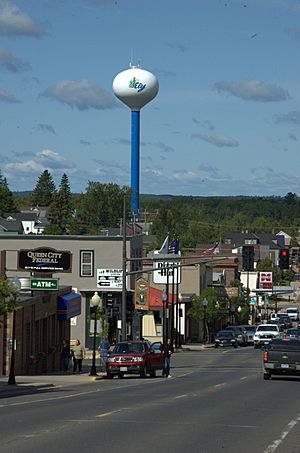 |
|
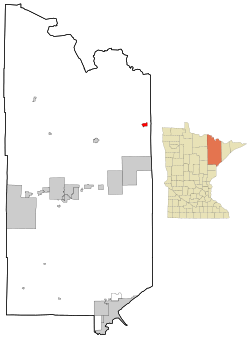
Location of the city of Ely
within Saint Louis County, Minnesota |
|
| Country | United States |
| State | Minnesota |
| County | St. Louis |
| Area | |
| • Total | 2.93 sq mi (7.59 km2) |
| • Land | 2.92 sq mi (7.57 km2) |
| • Water | 0.01 sq mi (0.02 km2) |
| Elevation | 1,434 ft (437 m) |
| Population
(2020)
|
|
| • Total | 3,268 |
| • Density | 1,117.65/sq mi (431.51/km2) |
| Time zone | UTC−6 (Central (CST)) |
| • Summer (DST) | UTC−5 (CDT) |
| ZIP Code |
55731
|
| Area code(s) | 218 |
| FIPS code | 27-19142 |
| GNIS feature ID | 0661205 |
| Website | www.ely.mn.us |
Ely (pronounced EE-lee) is a small city in St. Louis County, Minnesota, United States. In 2020, about 3,268 people lived there.
Ely is located in an area known for its iron ore. It's also a popular starting point for people who want to go camping and canoeing in the Boundary Waters Canoe Area Wilderness in the U.S. and Canada's Quetico Provincial Park. You can also visit the International Wolf Center and the North American Bear Center nearby.
Ely's main street has many shops for outdoor gear, clothing, and places to eat. Major roads like MN 1 and MN 169 pass through the city. Ely is about 16 miles (26 km) south of the Canadian border and is part of the Superior National Forest.
Contents
History of Ely
The first Europeans to visit this area were fur traders. They came looking for animal furs. Later, in 1865, many pioneers arrived during the Lake Vermillion gold rush. Not much gold was found, but people discovered huge amounts of iron ore here. Thousands of new immigrants came to America at that time. Many of them moved to this area, which became known as the Minnesota Iron Range, to find work in the mines.
In 1888, the Duluth, Missabe and Iron Range Railway built train tracks to Ely. This led to the opening of the Chandler Mine, starting Ely's mining operations. The ore was sent by train to docks on Lake Superior in Two Harbors and Duluth. From there, large ships carried it across the Great Lakes for processing.
That same year, miners started a town called Florence with 177 people. It was named after the daughter of the Chandler mine's captain. When more ore was found further west, the town moved and changed its name. Since another village in Minnesota was already called "Florence," the name "Ely" was chosen. It honored Samuel B. Ely, a mining executive from Michigan who helped promote the Vermilion Range ore. He never actually visited the town named after him!
The name "Ely" comes from the "Isle of Eels" in England. This was a wetland area where eels were common, providing food for Samuel B. Ely's ancestors. His family came to the U.S. in the 1600s. Samuel helped fund the railroad to Ely in 1888, which helped the town grow.
The first grocery store in Ely was a small log building. The first wooden building was a hardware and furniture store, built in 1887. The Pioneer Hotel also opened that year. The first school started in 1889 with 112 students.
Many mines opened in Ely, including the Pioneer Mine (1889), the Zenith (1892), the Savoy (1899), and the Sibley (1899). The Pioneer Mine was the most successful, producing 41 million tons of ore. This was 40% of all the ore from the Vermilion Range! In total, 11 mines opened near Ely. The Pioneer mine closed in 1967. Today, its old offices are home to the Ely Arts & Heritage Center.
At first, mining was done in open pits. But when the easy-to-reach ore ran out, deep tunnels were dug underground. This needed lots of wooden beams to support the tunnels. The need for wood also helped the logging industry grow. Logging still happens in the area today, but on a smaller scale.
Geography and Climate
Ely covers about 2.74 square miles (7.10 km²). Most of this is land, with a small amount of water.
Ely is located about 100 miles (161 km) north of Duluth. It is 117 miles (188 km) southeast of International Falls. The city is also 244 miles (393 km) north of the Twin Cities.
Ely's Weather
| Weather chart for Ely | |||||||||||||||||||||||||||||||||||||||||||||||
|---|---|---|---|---|---|---|---|---|---|---|---|---|---|---|---|---|---|---|---|---|---|---|---|---|---|---|---|---|---|---|---|---|---|---|---|---|---|---|---|---|---|---|---|---|---|---|---|
| J | F | M | A | M | J | J | A | S | O | N | D | ||||||||||||||||||||||||||||||||||||
|
27
-9
-22
|
20
-5
-21
|
34
2
-12
|
58
10
-4
|
76
18
3
|
107
24
9
|
114
26
12
|
87
26
11
|
122
20
7
|
73
11
0
|
43
1
-7
|
34
-6
-16
|
||||||||||||||||||||||||||||||||||||
| temperatures in °C precipitation totals in mm |
|||||||||||||||||||||||||||||||||||||||||||||||
|
Imperial conversion
|
|||||||||||||||||||||||||||||||||||||||||||||||
Ely has a climate with warm summers and very cold, long winters. Winters can start in October and last until April.
On February 13, 2021, Ely had a record low temperature of -50°F (-45.6°C). This was a new daily record for the city.
Population of Ely
| Historical population | |||
|---|---|---|---|
| Census | Pop. | %± | |
| 1890 | 901 | — | |
| 1900 | 3,717 | 312.5% | |
| 1910 | 3,572 | −3.9% | |
| 1920 | 4,902 | 37.2% | |
| 1930 | 6,156 | 25.6% | |
| 1940 | 5,970 | −3.0% | |
| 1950 | 5,474 | −8.3% | |
| 1960 | 5,438 | −0.7% | |
| 1970 | 4,904 | −9.8% | |
| 1980 | 4,820 | −1.7% | |
| 1990 | 3,968 | −17.7% | |
| 2000 | 3,724 | −6.1% | |
| 2010 | 3,460 | −7.1% | |
| 2020 | 3,268 | −5.5% | |
| U.S. Decennial Census | |||
Ely's People (2010 Census)
In 2010, Ely had 3,460 people living in 1,681 homes. About 95.9% of the people were White. About 16% of residents were under 18 years old. The average age in the city was 45.3 years.
Ely's People (2020 Census)
By 2020, Ely's population was 3,268 residents.
Arts and Culture in Ely
Ely has many fun community events in Whiteside Park. These include the Blueberry Arts Festival in July, the Harvest Moon Festival in September, and the Winter Festival in February. There is also a special art gallery called Art & Soul Gallery that features local artists.
The Ely post office has two beautiful murals painted by Elsa Jemne in 1941. They are called Iron-Ore Mines and Wilderness. These murals were created during the New Deal era to bring art to public buildings.
North American Bear Center
Ely is home to the North American Bear Center, which opened in 2007. It's an exciting museum where you can learn about American black bears. It's the only science museum of its kind that focuses on bears. You can watch four real bears in a large, natural outdoor area with a pond and waterfalls. The center also has exhibits, a theater, and activities for kids.
International Wolf Center
The International Wolf Center is a top organization for teaching people about wolves. It was started in 1985 by L. David Mech, a famous wolf scientist, and opened in 1993. At the center, you can see gray wolves through big windows. You can watch them play, hunt, and communicate. The center also offers many educational programs, like howling trips, radio tracking, and snowshoe treks.
Ely Arts & Heritage Center
The Ely Arts & Heritage Center is located in the old Pioneer Mine complex. It's run by a group called Ely Greenstone Public Art. They offer art classes, exhibits, and festivals for the community.
Dorothy Molter Museum
The Dorothy Molter cabin and museum are in Ely. Dorothy Molter was known as the "Root Beer Lady." She lived for 56 years on Knife Lake in the BWCAW. She became famous, and thousands of canoeists would stop by to visit her and drink her homemade root beer.
Dorothy was born in 1907. She first visited Knife Lake in 1930 and made it her home in 1934. Her home, the Isle of Pines Resort, was once reachable by seaplanes and snowmobiles.
After a flight ban in 1949, Dorothy had to get her root beer supplies by boat. Canoeists often helped her by bringing supplies from town. They would sometimes leave an oar behind, and hundreds of these oars are now displayed at the museum.
In 1964, her land was taken by the Wilderness Act. But after many people protested, she was allowed to stay. Most motorized travel to her home was stopped, and other buildings were removed. Dorothy became the only full-time resident in a huge wilderness area. After she passed away, her cabins and belongings were moved to Ely by boat. They were rebuilt there to create the Dorothy Molter Museum. Today, the museum still sells her root beer to keep her story alive.
Ely-Winton History Museum
The Ely-Winton History Museum is on the Vermilion Community College Campus. It shows the history of the area through displays, photos, and stories. You can learn about logging and mining with old tools and rock samples. The museum also highlights the important role of women in the early days. In 2018, they opened an exhibit of paintings about Ely's mining history by Albin Zaverl. They also have art by Ojibwe artist Carl Gawboy, who grew up in Ely.
Historic Places in Ely
The U.S. National Register of Historic Places lists buildings and sites that are important to history. Several places in and around Ely are on this list: Bull-of-the-Woods Logging Scow, Ely State Theater, Listening Point, and Tanner's Hospital.
Listening Point was the private retreat of Sigurd Olson, a famous conservationist. He bought the property in 1956 and moved a log cabin and sauna there. Today, the Listening Point Foundation works to preserve it as an outdoor museum.
The Ely State Theater was built in 1936. It's a great example of the "Streamline Moderne" style of architecture.
Tanner's Hospital was built in 1901. It was a hospital during a time when many people in mining towns got sick due to poor sanitation.
The Bull-of-the-Woods Logging Scow is a small paddle steamer that sank in Burntside Lake. It was built around 1893 for logging companies. These boats, sometimes called "alligators" or "gators," could pull timber rafts and even move themselves across land. This scow is the only one of its kind still known to exist.
Parks and Outdoor Fun
There are many hiking trails in the Ely area. The Echo Trail (Saint Louis County Road 116) is known as one of Minnesota's most beautiful trails. It's a former logging road that goes north and west from Ely. This 72-mile (116-km) road goes through the Superior National Forest and Kabetogama State Forest. It's the main way to reach the lakes in the western part of the BWCAW.
The Trezona Trail offers historic views of the old iron ore mines.
The Kekekabic Trail, or "The Kek," is a hiking trail about 39 miles (63 km) long. It starts in Ely and ends at the Gunflint Trail.
The Mesabi Trail is a paved biking trail that begins in Ely. It stretches about 120 miles (193 km) across the Mesabi Iron Range to Grand Rapids.
Since 2015, Ely has hosted the Ely Marathon. Runners race from Burntside Lake down the Echo Trail into the city. It's famous for being the only marathon with a "canoe portage" category. This means some racers carry a canoe for part of the race!
Outdoor Attractions
Ely is the biggest "jumping off" point for the Boundary Waters Canoe Area Wilderness (BWCAW). It's also a major entry point for Quetico Provincial Park in Canada. The BWCAW is famous for canoeing and fishing on its many lakes. It's the most visited wilderness area in the United States. Ely offers many services for wilderness trips, making it a top spot for canoe outfitting in the world.
Sigurd F. Olson, who lived in Ely for a long time, was very important in creating the BWCAW. He was a writer and an environmentalist who worked to protect wilderness. He spent over 30 years as a wilderness guide in the lakes and forests of northern Minnesota and Canada. He helped create the Wilderness Act of 1964 and Voyageurs National Park. People called him the Bourgeois, a term for trusted leaders.
Outfitters in Ely
Ely is a main gateway to the American side of the BWCAW. About 250,000 people visit Ely each year to go into the wilderness. To help all these visitors, Ely has about 20 outfitters. These companies provide gear and information for trips. Not everyone can afford or store their own gear, and outfitters help people know what they need. Some outfitters specialize in short day trips, while others offer week-long trips or even provide guides.
Camp Widjiwagan
Camp Widjiwagan is a wilderness camp for girls and boys on Burntside Lake. The camp is well-known for its canoeing and backpacking programs. It also has an environmental education program. In the summer, they offer canoe and backpacking trips for different skill levels. In the fall, winter, and spring, students learn about wilderness survival, plant identification, hiking, animal tracking, and snowshoeing. Joe Seliga, a master builder of wood-and-canvas canoes, lived in Ely and taught at the camp. After he passed away, Camp Widjiwagan received his canoe building form.
Hegman Lake Pictographs
The Hegman Lake Pictographs are located in the BWCAW, about 15 miles (24 km) north of Ely. They are considered some of the most famous rock paintings in Minnesota. These ancient rock art pieces are on a large rock wall on North Hegman Lake. They are believed to have been created by the Ojibwe people. The meaning of the paintings is not fully known. Some think they show stars that helped with navigation in winter. Others believe they represent a connection between the spiritual and natural worlds. In summer, you can only reach the site by canoe. In winter, when the lakes are frozen, you can walk there, using snowshoes if the snow is deep.
Charles L. Sommers Canoe Base
The Boy Scouts of America's national Charles L. Sommers Canoe Base is a place for canoe trips and winter camping activities.
Education in Ely
The Ely Public School District has two public schools:
- Ely Memorial High School (Grades 6–12)
- Washington Elementary School (Grades Pre-K-5)
Ely is also home to Minnesota North College – Vermilion, which used to be called Vermilion Community College.
Ely has a public library, the Ely Public Library. It is part of the Arrowhead Library System. The library moved to a new building in 2014.
Media in Ely
Ely has two local newspapers, the Ely Echo and the North Country Angler. It also has a radio station, WELY.
Famous People from Ely
- Jessica Biel – an actress, born in Ely.
- Jim Brandenburg – a photographer for National Geographic.
- Jim Klobuchar – a journalist.
- Lynn Rogers – an expert on black bears.
Ely's Fun Hoaxes
People from Ely, with help from the city council, have created funny hoaxes to get free attention for the city. One story was about a made-up family that "paints the leaves" on trees every fall. They said the family was retiring and asked people to apply to help continue the tradition.
Another hoax was that Ely was leaving the United States to join Canada! Both of these funny stories were on Ely's Chamber Of Commerce website. In 2009, Ely even made a joke bid to host the 2016 Olympics. They even joked that someone was already hired to drain a lake to make room for stadium seating! This hoax became very well known in Minnesota, with "Ely in 2016" signs and bumper stickers everywhere.
Images for kids
See also
 In Spanish: Ely (Minnesota) para niños
In Spanish: Ely (Minnesota) para niños





